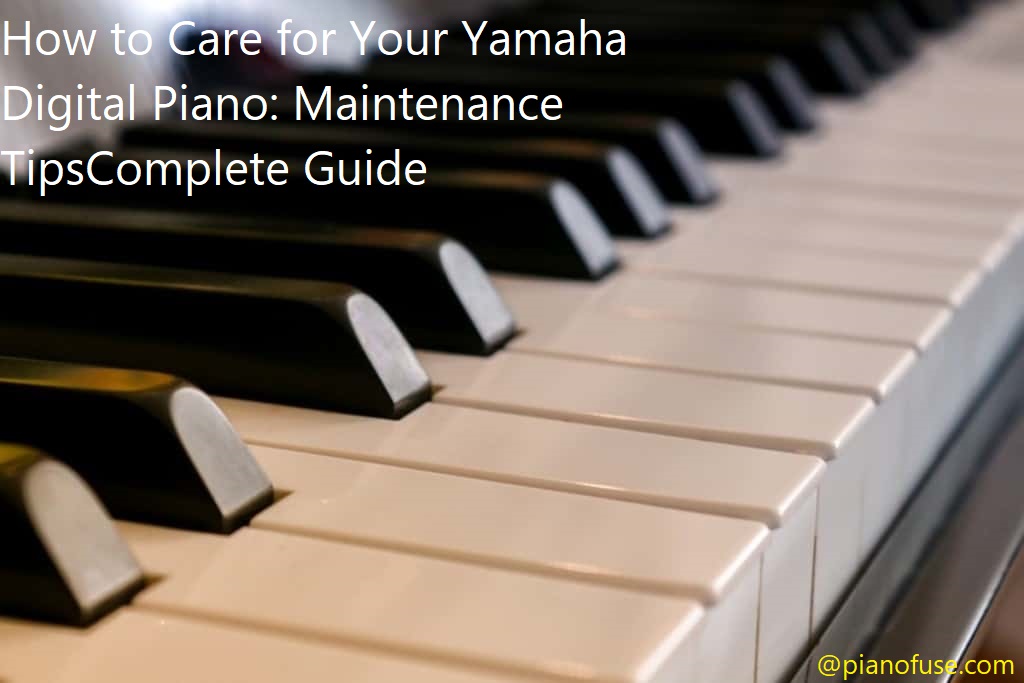Do you want your Yamaha Digital Piano to last a lifetime? With proper maintenance, it can!
Here you will learn how to care for, maintain and ensure your Yamaha Digital Piano delivers optimal performance. You’ll be sure that you get the most out of your piano and keep it in top condition.
Caring for your Yamaha digital piano is essential in order to ensure it retains its quality and performs optimally. Regular maintenance and understanding the proper usage of the instrument helps protect your investment and boost the lifespan of your piano. It also enhances the quality of sound it produces, allowing you to enjoy a more satisfying experience with its use.
This guide provides practical tips and advice on properly caring for your Yamaha digital piano, helping you make full use of it for years to come. From regular cleaning and avoiding dust build-up, to its proper storage and usage tips – this guide covers it all.
Overview of maintenance tips
It is important to keep regular maintenance on a digital piano to ensure it plays in top condition, lasts longer and sounds its best. Basic maintenance includes cleaning and inspecting the keys, checking the connections, tightening loose screws and occasionally lubricating the insides of the piano. Proper care can help ensure your Yamaha digital piano holds its value over time while consistently sounding clear, rich and balanced. Regular care of your Yamaha digital piano also helps you detect possible problems early before they become bigger issues.
In this guide we will provide you with an overview of maintenance tips for Yamaha digital pianos as well as an explanation of general symptoms for some common issues. We will discuss preventive measures such as cleaning, home inspections and appropriate storage options as well as other techniques that can help prolong the life of your prized instrument.

Brief history of Yamaha digital pianos
Yamaha digital pianos have been setting benchmarks for innovation and quality since 1987. Since then, Yamaha has provided a wide-range of digital pianos, from entry-level models to high-end concert grand pianos. The development of the first digital piano started as an experiment within the company’s Advanced Technology Center in Hamamatsu. After several years of research and development, the first Yamaha digital piano was released in 1987 and it was an instant success.
Over the past 30 years, Yamaha has continually refined and improved on their digital piano technology, creating some of the best instruments in existence today. In addition to consistently high standards in terms of sound, touch and design, Yamaha’s commitment to innovation over the past thirty years has resulted in such breakthroughs as Graded Hammer Standard (GHS) key weighting system and PureCF sampling technology.
With their continued commitment to pushing the boundaries of piano accuracy and realism along with stylish modern designs of their pianos – long seen by musicians around the world – it is no surprise that Yamaha remains one of the best manufacturers in this field today.
Cleaning and Dusting
Cleaning and dusting your Yamaha digital piano is an essential part of the maintenance process and something you should do regularly. Yamaha digital pianos come with a variety of finishes, so it is important to take the necessary steps in protecting these delicate surfaces. Depending on the model, surfaces may range from a high gloss paint to lacquered wood. For both types, dusting is essential to preserve the beautiful finish and ensure your instrument looks its best. When cleaning your digital piano here are some tips:
-For glossy and lacquered finishes use a dry, soft cloth such as cheesecloth or microfiber and lightly wipe down all surfaces to remove dust. A common mistake is using furniture polish or other applying other treatments on these types of finishes- this could have a negative effect on them!
-To clean stubborn fingerprints and other smudges from glossy paint, use a mild solution of soap and lukewarm water (dissolve one teaspoonful of clear dish soap in one quart of water). Moisten cloth slightly with the soapy water solution but do not let any liquid come into contact with your piano’s keybed or controls as it could damage them.
-For wooden surfaces such as maple or walnut use a damp sponge but refrain from using too much moisture. Wipe up any extra moisture immediately after drying to prevent damage to the finish by making sure no liquid stays behind.
-Always place protective covers over your piano when not in use; this will help guard against dirt and debris that can build up over time if left exposed or collected when people enter the room wearing outside shoes they may track in little bits of dirt particles that quickly build up on delicate keys which over time can cause issues such as stuck keys etc.
Materials needed for cleaning
Taking proper care of your digital piano is essential for optimal performance and longevity. Depending on the type of piano you have, there are certain materials you will use to properly clean and maintain your instrument. Below is a list of some of the most common supplies used when cleaning digital pianos:
-Soft cloths: A variety of different soft cloths and microfiber towels may be used during the cleaning process. This prevents any damage or scratches that could be caused by using rougher materials or scrubbing too hard.
-Wood cleaner: Some pianos may require a specific wood cleaner if they are made with real wood, so it’s important to find out if this is necessary before applying anything.
-Keyboard cleaner wipes: You can purchase individually packaged cleaning wipes designed specifically for your digital piano keyboard and keys with anti-bacterial protection, which can help keep dirt, dust, grime and bacteria from building up inside the instrument.
-Feather duster: For more thorough dusting jobs, a feather duster will pick up deeper dust particles than a swab or cloth alone can pick up. Using this tool can help ensure that all excess dirt and dust are removed from the exterior of your instrument.
Steps to follow when cleaning your Yamaha digital piano
It is important to properly clean and maintain your Yamaha digital piano to keep it looking good and sounding its best. To do this, there are three main steps that you can follow:
- Cleaning the keys The keys on a Yamaha digital piano are made from different materials that may require different cleaning techniques. Use a soft dry cloth or a damp cloth dampened with water to carefully clean each key top, paying special attention to any cracks or crevices. You may want to use an electronic keyboard cleaner spray if the dirt or dust is particularly hard to remove. Avoid using any type of abrasive cleaners as they could damage the keys and cause wear over time.
- Cleaning the exterior Most Yamaha digital pianos have a plastic casing that can be easily dusted with a microfiber cloth or vacuumed using an attachment designed for delicate surfaces like electronics or furniture. Avoid using chemical-based cleaners as they could potentially damage the plastic case’s finish and cause wear over time.
- Polishing the exterior Oftentimes, your Yamaha digital piano will need a bit of extra care when it comes to polishing in order to keep it looking its best for longer periods of time. Use a quality piano polish dedicated specifically for wooden finishes and wipe down lightly with soft circular motions until evenly distributed across all exterior surfaces – do not oversaturate your polishing cloth as this could create more dirt and grime when attempting to clean them off later on! Be sure also not take on extensive DIY projects such as sanding, staining or varnishing unless you have prior experience in those areas; these tasks should always be left up to experienced professionals who specialize in woodworking/restoration work!

Protecting Your Yamaha Digital Piano
In order to maintain the quality of sound and extend the life of your Yamaha digital piano, it is important to protect it from dust, dirt and other environmental factors. Below are some tips to help keep your piano in top condition:
- Keep away from direct sunlight, excessive humidity or dryness, and extreme temperature changes. If possible, find a place with a stable environment free from these conditions.
- Consider purchasing indoor/outdoor covers for your piano that fit properly and protect against moisture buildup when transporting or storing the instrument outdoors.
- Make sure to clean off any dirt or dust on a regular basis with a soft cloth dampened in mild soapy water; avoid doing this when keys are wet with condensation as it can cause damage to them over time. Avoid using aerosol sprays near the instrument as they can leave harmful residuals that can stay inside crevices and harm parts such as felt hammers and pedals if inhaled too frequently. There may also be cases where metallic parts start rusting due to the spray’s content; thus it is always best practice to wipe down surfaces instead using something that is softer than just paper or cotton materials (like microfiber cloths).
- Cover your digital piano when not in use—this will reduce wear on the keys over time and make sure any dust/dirt particles do not get trapped under them as well as preserve their overall color and aesthetic appeal for longer periods of time (preferably make sure cover is made out of breathable material). Additionally, investing into external covers such as felt ones can also be good way protect both internal electronics from static electricity shocks while adding an extra layer protection against spills etc.).
How to protect the keys and other delicate parts of your piano
In this section, we will discuss how to maintain your Yamaha digital piano in order to protect the keys and other delicate parts of your instrument. Digital pianos are built with sensitive parts so proper care should be taken when using and storing it. Here are some tips on how to look after and protect your piano:
- Store the piano in a dust-free environment – keep away from dust, sunlight and humidity;
- When not in use, cover the keys with a soft cloth – avoid sharp materials that could damage the keys;
- Use cleaning supplies such as foam cleaner onto key surfaces gently;
- Occasionally check the pedal systems for smooth movement;
- Keep an eye out for any condition changes in the power cord, plug or jacks – make sure intricate parts remain dry and free of debris like dust or wax.
Strategies for preventing damage to your piano
To keep your Yamaha digital piano in excellent condition, it is important to take preventative measures and consider taking necessary precautions to maintain the instrument’s overall quality. A few key strategies for preventing damage to your Yamaha digital piano include:
-Regularly check the dust cover and ensure that it fits snugly over to the entire instrument.
-Make sure to use appropriate amounts of pressure when pressing the keys, as excessive force can cause damage.
-Keep food and drinks away from your piano as spills can cause damage and be difficult to clean up.
-Be mindful of any heavy objects near your piano as vibrations or shocks can cause serious damage.
-Periodically tune your digital piano, as regular maintenance ensures that all parts are in perfect working order.
-Keep your digital piano away from direct sunlight or any place with extreme temperatures, which could lead to rusting or warping of parts over time.

Conclusion
Taking care of your Yamaha digital piano should be easy with the tips provided in this guide. Regularly scheduled maintenance will keep your instrument in good condition so you can continue to make beautiful music. Additionally, being aware of any potential hazards and following basic safety procedures is important for ensuring a safe playing environment. Ultimately, your digital piano will last for many years when it’s treated with care and respect.
In conclusion, be sure to practice good maintenance habits such as cleaning surfaces regularly, changing settings as needed, identifying and repairing hardware problems, and protecting against extreme temperatures or humidity. Also remember to have repairs performed promptly by qualified technicians or authorized personnel if problems arise. When following these tips may help you achieve years worth of lasting music-making performance from your Yamaha digital piano.
FAQ’S
How do you clean a Yamaha digital piano?
To clean a Yamaha digital piano, use a soft, dry cloth to wipe down the keys and body of the instrument. Avoid using water or cleaning products that could damage the finish.
Do digital pianos need maintenance?
Yes, digital pianos do require some maintenance, such as dusting the keys and keeping the instrument clean and free from moisture.
How long does a Yamaha digital piano last?
With proper maintenance and care, a Yamaha digital piano can last for many years, even decades. However, the lifespan of the instrument may depend on factors such as usage and storage conditions.
Should I unplug my digital piano?
Yes, it is a good idea to unplug your digital piano when it is not in use to help protect the instrument from power surges and other electrical issues.
What maintenance does a digital piano need?
Digital pianos typically require regular cleaning, dusting, and occasional tuning or calibration. It is also important to keep the instrument away from moisture and extreme temperatures.
Can dust damage a digital piano?
Yes, dust and dirt can accumulate on the keys and inside the instrument, potentially causing damage over time. Regular dusting and cleaning can help prevent this.
How do you take care of a Yamaha piano?
To take care of a Yamaha piano, keep it clean and dry, avoid exposing it to extreme temperatures or humidity, and have it professionally tuned as needed.
How do you take care of a Yamaha keyboard?
To take care of a Yamaha keyboard, clean it regularly, protect it from moisture and extreme temperatures, and avoid exposing it to direct sunlight or other sources of heat.
Is Yamaha a good digital piano brand?
Yes, Yamaha is a highly respected brand in the world of digital pianos and is known for producing high-quality instruments with realistic sound and feel.
Does a digital piano need piano key cleaner?
It is not necessary to use a specific piano key cleaner on a digital piano, but regular dusting and cleaning with a soft, dry cloth can help keep the keys clean and free from dirt and debris.
See Also:
- Best piano mic 2023
- Best portable digital piano 2023
- Best portable piano keyboards 2023
- Best upright piano 2023
- Best yamaha digital piano 2023


